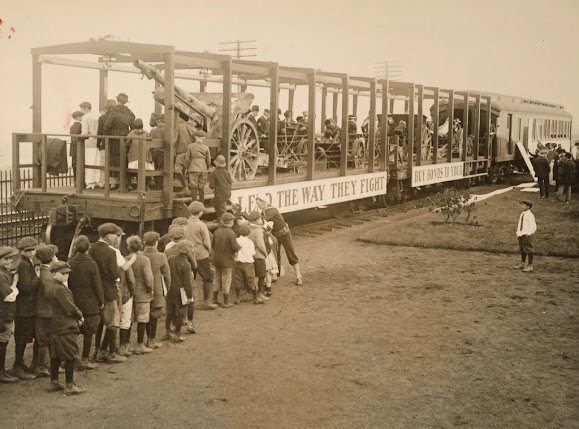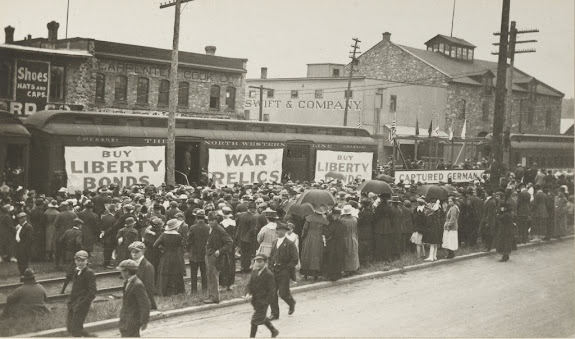In April and May of 1919, there were 24 War Relic Trains touring the continental United States.
These popular rolling museums brought the material culture of military training camps and French battlefields to Americans where they lived: as a war loan official observed, “carrying the war into the homes and the hearts of the people as it never had been brought them before.”
"Included in the equipment of this spectacular train are German guns that spouted death at St. Mihiel and the Argonne, death bombs of the North Atlantic convoy service, French "75's" the most famous light artillery of the war, a tank, an armored car and "field" wireless apparatus. Five carloads of death-dealing appliances comprise the exhibit. The camouflaged guns, the scarred land-battle ships and all the other deadly exhibits have belched their message of hate. Just their new "drive" is not one of destruction.
Its objects are reconstruction. Accompanying the train is a detail of U. S. Marines from overseas, combat crews from fighting machines, and a corps of loan speakers. The Marines will set up their "wireless" at each stop and will "flash" headquarters for instructions." - April 1918 [various papers]
The tank a speedy whippot with a real treat-em-rough crew and the armored car, also manned by army "bear -cats," will also descend from the train..
The trains, made stops in different towns, raising money for the Victory Loans. It was not the trains first stop to the area, in October of 1918, the traveling exhibit had stopped in Milton, Lewisburg, Mifflinburg, Middleburg, and Selinsgrove. The exhibits viewed in 1918 however, may have been different than the ones passing through in 1919.
"The principal exhibits will be German war materials captured by American fighting men in France. It will include trench mortars, the famous hun "minneweffer" guns, boche rifles with bayonets, Austrian air-craft guns and hundreds of other trophies. There will also be car-loads of ordinance and equipment used by the Allies, American machine guns, 14- inch siege guns, grenades, torpedoes, air bombs, 77 and 166 multimeter guns, shells and depth bombs. The train will be in charge of lecturers, who will explain the significance of all the exhibits. It will show the people back home what the fighting men over seas are confronting, and will prove a convincing argument why more bonds shall be bought that the war campaign can continue to he prosecuted so successfully and hasten the day when the victorious Allies shall dictate to the mad hun the terms on which a permanent peace shall be established." - Selinsgrove Times, October 1918
The train also exhibited in Northumberland & Catawissa in October 1918, but due to the Spanish Flu, those in Bloomsburg and Danville were not allowed to view the exhibits.
In Milton in October of 1918, the train was only at the station for 50 minutes. In those 50 minutes, the 4,000 visited the exhibit.
The train was late to Lewisburg, and was only able to stop for 15 minutes in that town before heading on to Mifflinburg.
The trains were called war exhibit trains, war exhibition trains, war relic trains, Victory Loan Trophy trains.













.jpg)
No comments:
Post a Comment
I'll read the comments and approve them to post as soon as I can! Thanks for stopping by!